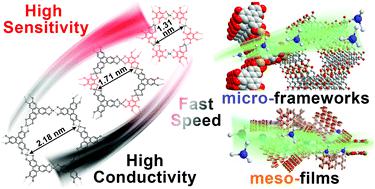当前位置:
X-MOL 学术
›
Dalton Trans.
›
论文详情
Our official English website, www.x-mol.net, welcomes your
feedback! (Note: you will need to create a separate account there.)
A comparative study of honeycomb-like 2D π-conjugated metal–organic framework chemiresistors: conductivity and channels
Dalton Transactions ( IF 3.5 ) Pub Date : 2021-09-06 , DOI: 10.1039/d1dt02323c Ming-Shui Yao 1 , Ping Wang 1 , Yi-Fan Gu 1 , Tomoyuki Koganezawa 2 , Hirotaka Ashitani 3 , Yoshiki Kubota 3 , Zao-Ming Wang 1 , Ze-Yu Fan 1 , Ken-Ichi Otake 1 , Susumu Kitagawa 1
Dalton Transactions ( IF 3.5 ) Pub Date : 2021-09-06 , DOI: 10.1039/d1dt02323c Ming-Shui Yao 1 , Ping Wang 1 , Yi-Fan Gu 1 , Tomoyuki Koganezawa 2 , Hirotaka Ashitani 3 , Yoshiki Kubota 3 , Zao-Ming Wang 1 , Ze-Yu Fan 1 , Ken-Ichi Otake 1 , Susumu Kitagawa 1
Affiliation

|
Two-dimensional (2D) π-conjugated conductive metal–organic frameworks (cMOFs, 2DπcMOF) with modulated channel sizes and a broad conductivity range have been reported in the last decade. In contrast, the corresponding comparative studies on their effects on chemiresistive sensing performances, which measure the resistive response toward external chemical stimuli, have not yet been reported. In this work, we sought to explore the structure–performance relationships of honeycomb-like 2D π-conjugated cMOF chemiresistive gas sensors with channel sizes less than 2 nm (the mass transport issue) and broad conductivity in the range from ∼10−8 S cm−1 to 1 S cm−1 (the charge transport issue). As a result, we found that the cMOF with a lower conductivity facilitates the much more sensitive response toward the charge transfer of the adsorbed gases (relative increases in resistance: R = 63.5% toward 100 ppm of NH3 for the as prepared Cu–THQ sensor with the conductivity of ∼10−8 S cm−1). Interestingly, the cMOF with a medium channel size (Cu–THHP–THQ) exhibited the fastest response speed in sensing, although it contains H2en2+ as neutralizing counterions in the channels. From the evaluation of the pore size distribution, it is found that the overall porosity (meso- & micro-pores) of cMOFs, rather than the pore size of the honeycomb structure, would determine their sensing speed. When comparing the performance of two different morphologies of nanorods (NRs) and nanosheets (NSs), NRs showed a slower response and extended recovery time, which can be ascribed to the slower gas diffusion in the more extended 1D channel. Altogether, our results demonstrate the first systematic studies on the effect of various structural parameters on the chemiresistive sensor performance of cMOFs.
中文翻译:

蜂窝状二维π共轭金属有机骨架化学电阻的比较研究:电导率和通道
在过去的十年中,已经报道了具有调制通道尺寸和宽导电范围的二维 (2D) π 共轭导电金属有机骨架(c MOFs,2DπcMOF)。相比之下,尚未报道关于它们对化学电阻传感性能影响的相应比较研究,化学电阻传感性能测量对外部化学刺激的电阻响应。在这项工作中,我们试图探索蜂窝状 2D π 共轭c MOF 化学电阻气体传感器的结构 - 性能关系,其通道尺寸小于 2 nm(传质问题)和广泛的电导率范围从 ~10 -8 S cm -1至 1 S cm -1(收费运输问题)。结果,我们发现具有较低电导率的c MOF 促进了对吸附气体电荷转移的更敏感的响应(电阻的相对增加:对于所制备的 Cu– 100 ppm NH 3,R = 63.5% THQ 传感器的电导率约为 10 -8 S cm -1 )。有趣的是,具有中等通道尺寸的 cMOF (Cu-THHP-THQ) 在传感方面表现出最快的响应速度,尽管它包含 H 2 en 2+作为通道中的中和反离子。从孔径分布的评估中发现,c的总孔隙率(中孔和微孔)MOFs,而不是蜂窝结构的孔径,将决定它们的传感速度。当比较两种不同形态的纳米棒 (NRs) 和纳米片 (NSs) 的性能时,NRs 表现出较慢的响应和较长的恢复时间,这可以归因于更扩展的一维通道中气体扩散较慢。总之,我们的结果证明了对各种结构参数对c MOF化学电阻传感器性能影响的首次系统研究。
更新日期:2021-09-06
中文翻译:

蜂窝状二维π共轭金属有机骨架化学电阻的比较研究:电导率和通道
在过去的十年中,已经报道了具有调制通道尺寸和宽导电范围的二维 (2D) π 共轭导电金属有机骨架(c MOFs,2DπcMOF)。相比之下,尚未报道关于它们对化学电阻传感性能影响的相应比较研究,化学电阻传感性能测量对外部化学刺激的电阻响应。在这项工作中,我们试图探索蜂窝状 2D π 共轭c MOF 化学电阻气体传感器的结构 - 性能关系,其通道尺寸小于 2 nm(传质问题)和广泛的电导率范围从 ~10 -8 S cm -1至 1 S cm -1(收费运输问题)。结果,我们发现具有较低电导率的c MOF 促进了对吸附气体电荷转移的更敏感的响应(电阻的相对增加:对于所制备的 Cu– 100 ppm NH 3,R = 63.5% THQ 传感器的电导率约为 10 -8 S cm -1 )。有趣的是,具有中等通道尺寸的 cMOF (Cu-THHP-THQ) 在传感方面表现出最快的响应速度,尽管它包含 H 2 en 2+作为通道中的中和反离子。从孔径分布的评估中发现,c的总孔隙率(中孔和微孔)MOFs,而不是蜂窝结构的孔径,将决定它们的传感速度。当比较两种不同形态的纳米棒 (NRs) 和纳米片 (NSs) 的性能时,NRs 表现出较慢的响应和较长的恢复时间,这可以归因于更扩展的一维通道中气体扩散较慢。总之,我们的结果证明了对各种结构参数对c MOF化学电阻传感器性能影响的首次系统研究。











































 京公网安备 11010802027423号
京公网安备 11010802027423号